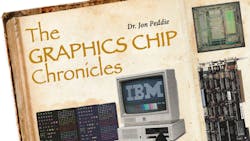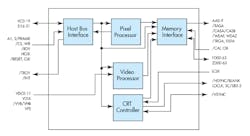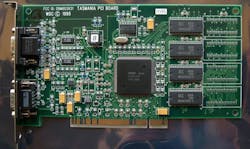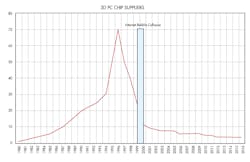Yamaha’s YGY611: A Pioneer in 3D Graphics
This article is part of the Electronics History series: The Graphics Chip Chronicles
Yamaha was a developer of video display controllers or processors (VDP) in the late 1980s. The company made IBM-compatible CGA display controllers, including the YGY603. The company also made the video display processor (VDP) for the Sega Genesis game console as well as the VDP for TI’s popular TI-99 calculator.
Yamaha was best known for its audio signal processors but the same fundamental principles of signal processing also apply to graphics and, in 1994, the company announced its 3D graphics processor—what it called the Rendering Polygon Accelerator (RPA)—the YGV611. Yamaha developed it for use in Pachinko machines.
Yamaha Systems Technology’s YGV611 was designed to deliver high-speed rendering in 2D/3D for PCs or lower-cost workstations. The processor featured high-speed short vector drawing, Gouraud shading, texture mapping, video capture, hidden surface removal and BitBLT. The chip had a 16-/32-bit host bus interface that could operate up to 33 MHz and a 128-bit (64 interleaved) memory interface, which was essential in high-performance 2D and 3D graphics. The RPR supported up to 1280 x 1024 16-bit color.
Yamaha officially introduced the chip at Comdex in 1994. The company said that it was the culmination of a decade of research into 3D and IC technology.
The specifications:
- 33 MHz clock frequency
- 550K polygons/second with Gouraud shading
- 270K polygons/second with Gouraud shading and texture map
- 32-bit color support
- 16-bit (DRAM or VRAM ) Z-buffer support with no performance penalty
- Dual-buffering at 32 bits
- Support for up to 32 Mbytes of VRAM
- Frame buffer and texture map both stored in VRAM memory
- 240-pin QFP package
Although the chip was a 3D coprocessor, it lacked VGA capabilities. While it was not designed to support for perspective, it created the illusion of it through manipulation of the texture map. Lighting and 3D transforms were done by the host PC. The first version lacked perspective correction and so it was only for VL bus Pachinko machines and then adapted to the PC.
Additional features:
- Hidden Surface Removal (Z-buffer of 16 bits)
- Video Capture Functions
- Short Vector Drawing up to 1600Wsec
- BitBLT-T
- 6 Million Short Vectors per second Drawing
- 8 Million Character Block transfers/sec (9×11)
- Low-power CMOS, 240 SQFP
Henry Choy, Yamaha’s product manager, demoed the processor at Comdex. The chip was capable of drawing 3D lines, flat-shaded polygons, Gouraud shaded polygons, and Gouraud shaded polygons with texture mapping. While no absolute performance numbers were displayed at the time, the performance was very high, considering it was an ISA-bus board.
The chip was priced at less than $100 (roughly $250 in 2020 dollars) with a projected price of $600 ($1,500 today) for a board with 2 MB of VRAM, plus you needed a VGA AIB to go with it. That makes today’s supercomputer-class AIBs seem cheap.
At the time, Yamaha said they would bring out a second-generation chip that used DRAM to lower the board price to $300.
Shortly after Comdex, STB, Diamond, and Paradise announced they would build add-in boards (AIBs) using the chip, driving the price down to $80, with production scheduled for the second quarter of 1995.
The chip was an immediate hit, and several weeks later, at the GamesPC Consortium meeting, game developer Criterion Software used the chip to run a demo of its CyberStreet video game, which was based on its popular RenderWare game engine. Real-time video mapping was shown on a rotating cube.
Yamaha said at the time that they were working on the next-generation processor. It would support DRAM, strip out video support, sport an integrated LUT-DAC, and display at a maximum resolution of 640 × 480. The company promised to release it in the first quarter of 1995 with a SRP of less than $60.
At the meeting, I watched the same Criterion demo running on both the Yamaha and 3Dlabs hardware. From my standpoint, the GLiNT ran the demo better than the Yamaha as it relates to perspective. The Yamaha chip simulates perspective by warping the texture map while the GLiNT chip calculates true perspective. For example, the demo is a street scene with building walls made of stone, much like a Doom scene. The Yamaha demo displayed straight lines as wavy, while the GLiNT displayed them as truly straight.
While not one of the more well-known makers of 2D and 3D graphics chips at the time, Yamaha had been in the business for over 10 years. Back in the 1980s, Yamaha designed and manufactured Raster Technology systems.
In February 1995, Microsoft announced it was working with Yamaha and 3Dlabs to develop 3D DDI drivers for Windows 95. Microsoft was emphatic about 3D AIB offering hardware texture mapping for games.
For its part, Yamaha kept its promise, and in May 1995, announced the DRAM-based YGV612 processor. The new chip was both pin- and software-compatible with the VRAM-based YGV611. It would be offered for $40 (or around $100 in 2020 dollars). Production was scheduled for August.
“As the first 3D silicon available to them, the YGV611 immediately attracted the attention of independent software developers at Fall Comdex,” said Robert Starr, Yamaha Systems Technology’s assistant general manager and director of sales and marketing at the time. “Only two quarters after that, the YGV612 can satisfy the requirements of DOS and Windows 95 game developers,” he concluded.
Yamaha claimed the YGV612 could render 300,000 Gouraud shading polygons per second and 150,000 texture-mapped 50-pixel polygons per second with its Z-buffer capabilities. The company added that the chip could also handle hidden surface removal. Like the YGC611, The YGC612 supported resolutions up to 1280 × 1024 with 64K colors.
But unlike the YGC611, the YGV612 used the PCI bus and VL-bus (with glue logic). Yamaha believed the AIBs would sell in the $250 range ($625 in 2020 terms, or what the average modern AIB sells for).Once again, Western Digital adopted and used it in their Paradise Tasmania 3D AIB.
The lack of a standard API was the weak link at the time. Western Digital and vendors did not anticipate a standard interface layer for 3D APIs or applications until the second half of 1996 after Direct3D from Microsoft was fully defined and a Direct3D hardware abstraction layer (HAL) was in place. That forced chip suppliers to partner with software vendors and try to choose one who had the most games supported. Semiconductor suppliers and game developers struggled to get DOS games running by the end of the year. After that, support from the DOS incarnations of RenderWare, BRender, and Reality Lab was expected to bring additional titles.
Western Digital decided to use Yamaha’s popular polygon rendering approach. An alternative rendering technique, quadratic texture mapping, was being promoted by Nvidia with its NV1 chip.
If you've read other editions of this series, you’ve seen my reference to the following chart.
Yamaha was a victim of the times, too. By 1996, the PC market was at its peak. But venture capital started shifting from hardware to software. The Internet was the future, and if a company did not have a story to tell about The Internet, it was difficult to stand out.
After it peaked in 1994, the U.S. GDP started sliding. Even though unemployment was going down, dozens of promising startups failed because they could not find supporting partners or customers or investors—or a combination of all three. In 1994 and 1995, the Federal Reserve Board raised short-term interest rates by 3%. As long-term interest rates grew faster than short-term ones, employment growth fell from 3% to less than 2%.
Around this time, Yamaha shifted its interests and investments. The company redirected its R&D budget to new audio processors and Arm-based multimedia chips. There were no YGY613s or other 3D graphics chips coming out of Yamaha after 1996.
Beginning in the 1980s, Yamaha was a pioneer in graphics chips and a leader in 3D technology. It was disappointing to see them leave the category. But, taking the long view, their presence in the 3D chip market could be seen as a flash-in-the-pan.
The company retreated to the Pachinko market and in 2020 was shipping the YGV635 (G2). A newer version, the GP3, is currently in production, but this will probably be their last Pachinko processor.
Yamaha is reportedly pulling out of the market as the opportunity keeps shrinking.
This article is part of the Electronics History series: The Graphics Chip Chronicles
About the Author

Jon Peddie
President
Dr. Jon Peddie heads up Tiburon, Calif.-based Jon Peddie Research. Peddie lectures at numerous conferences on topics pertaining to graphics technology and the emerging trends in digital media technology. He is the former president of Siggraph Pioneers, and is also the author of several books. Peddie was recently honored by the CAD Society with a lifetime achievement award. Peddie is a senior and lifetime member of IEEE (joined in 1963), and a former chair of the IEEE Super Computer Committee. Contact him at [email protected].



